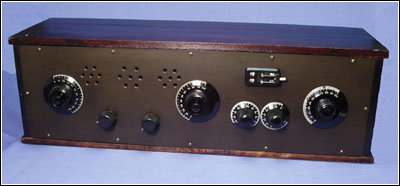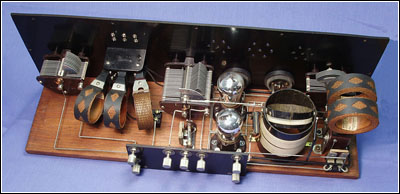Of Old Radios And Related Items--Published Monthly
Armstrong Super-Regenerative
Broadcast Receiver -- Circa 1922-1923
A Rare BirdBy Robert Lozier
Web Edition
Along with his recollections of the Robert Orr auction, Robert sent us this article on the set which he bought there, and which, at the time, he thought was just a nondescript home brew. (Editor)
Why write about a dull home brew like this?
Millions of radio enthusiasts around the world built or purchased broadcast receivers using the regenerative circuit in one form or the other. However, virtually no one actually built broadcast receivers using Howard Armstrong's super-regenerative receiver circuit that was disclosed to the public June 31, 1922.
While it was indeed true that amplification of radio signals approaching one million could be obtained with only two tubes, the output signal contained artifacts from the blocking (quench) oscillator that precluded really good audio quality when operated at medium wave broadcast frequencies. (Artifacts that would manifest in the form of a rushing sound in the background.) Add to that, the fact that the super-regen was generally considered very difficult to set up and operate successfully, and that you had a circuit by a world famous inventor that did not excite the public interest for a long time.
The real value of the super-regenerative circuit was not demonstrated until almost ten years later when there was a rapid increase in practical communications operation at VHF frequencies (above 50 MHz.).
A front view of Robert Lozier's super-regenerative receiver purchased at the Herbert Orr auction.
An view of the "guts" of the super-regenerative receiver.Think the super-regenerative circuit should be dead by now? Not so. It has found a niche in the designs for GigaHertz ultra, ultra low power receivers for battery-powered data collection systems like gas and water meters.
What about the little knife-switch on the front panel? I can only speculate on this. When Armstrong demonstrated this circuit, it was done with a loop antenna to show that the outfit would easily pick up the New York stations from inside a lecture hall. When this set was built, there was a three-circuit coil mount that permitted the signal to be applied via a long wire. Maybe the intention was to be able to use a loop antenna at a later date with the option of a switch select. Another theory could be that since the panel has three peepholes, it could be that the experimenter salvaged the panel from an earlier project.
Preservation of the Set
I obtained this set back in the early 1980s when the Bill Orr collection was sold at auction. It was in good shape, except for the front of the hard rubber front panel. The surface was somewhat rough and it looked as if someone had tried to protect the white filler in the knobs by giving them an over-coat of shellac which spilled over onto the panel in places. The general color was a very dull grayish brown due to natural oxidation aggravated by relatively high humidity, even though the back side of the panel is pretty much a semigloss jet black.
I noted that it would be a simple task to remove all the components from the panel. Doing that, I proceeded to remove the shellac with alcohol. That went very quickly. The next step was to smear on a coat of Goop waterless hand cleaner and rub down with a clean terry cloth. (Remember! Never use cleaners like 409, Super Clean, Purple Stuff, etc., when cleaning hard rubber or Bakelite. These caustic materials will dissolve/etch the surface in a heartbeat!)
Then I applied another generous coat of Goop. This time, I substituted the terry cloth with 0000-grade steel wool and used very light pressure and circular motion all over the panel for 10 to 20 minutes. Every few minutes during the process, I would wipe as much of the Goop off as possible and inspect the panel under strong light. I was looking to make sure that the coloration across the entire panel stayed as even as possible.
If I had continued this process long enough, I'd have gotten back to a black panel rather than a somewhat grayish brown tinted black. I decided that it was better to keep some of the oxidation evident for educational purposes.
If you know of another 1920s vintage super-regen, I'd sure like to exchange photos.
Robert Lozier, a collector of broadcast receivers for almost 40 years, is interested in the development of foreign radio technology. He has presented lectures on radio collecting in Italy, as well as on restoration and preservation techniques. His free time is spent developing restoration techniques and preparing radio artifacts for exhibition.
Scammed on the Internet
By William Gourd
Here at A.R.C., we have received a number of reports of Internet fraud attempts, some actually successful. We thank William Gould for his "confession" hoping it may save others from a similar fate. (Editor)
For a couple of months, I had a classified ad in A.R.C., seeking to sell some electronic equipment that I no longer use (amplifier, tuner, turntable, etc.). A few days ago, I concluded an e-mail correspondence with an apparent buyer in another country. The conclusion was that I was ripped off to the tune of $2,500, and I bloody well ought to have known better. I'm telling the story in order to warn others.
On May 10, I received an e-mail from ***@yahoo.com, (*** = specific info deleted) who said that she wanted to buy the turntable. The language, spelling, and sentence structure sounded foreign. We then exchanged several e-mails; she eventually told me that payment had been sent to me: a check in the amount of $2,500, which I was to cash, deduct the $150 price of the turntable, and send the rest to her "shipper" in London, England.
Red flags should immediately have come up, but they didn't, and I proceeded. She put me in touch via e-mail with the "shipper," ***shippingagent@yahoo.co.uk. He told me how to send the money to him via Western Union. I was vaguely uncomfortable with all of this, but not enough to come to my senses and cancel the deal. So I cashed the $2,500 cashier's check, drawn on Pinnacle Bank in Newcastle, Wyoming. The check bore a statement something like "If you can't read the tiny print in this area, the check is counterfeit." I couldn't read the tiny print. I dismissed it by telling myself that it's just my poor vision. I was about to be monumentally suckered.
On May 31, growing impatient with keeping someone else's money, I sent $2,350 (minus a sending fee) to "shipper" in London via Western Union. I even told him the Money Transfer Control Number! Had I waited only TWO MORE DAYS, I would have been rescued by the telephone call from my bank telling me that the check was counterfeit and that the bank had withdrawn $2,500 from my account to cover its loss. I had allowed myself to be led down the proverbial primrose path, and lost $2,350 as a result.
One more brief note, and I'll quit: While all of the above was occurring, another "buyer" said that "his client" was sending me a check. Days went by; no check. Finally, I asked him what was up. He said that he wasn't sure, but he guessed that now he'd just have to use my credit card. At least I had brains enough to smell this one, and simply said "No" and "Goodbye." That "buyer's" address was ***300@yahoo.com. And now I've received another e-mail message, from ***2000@yahoo.com, inquiring, in the same sort of stilted language, about the items that I have for sale. He will get no response!
It's interesting--all of these clowns are @yahoo.com. It must be a club. Be very careful out there.
| [Free Sample] [Books, etc., For Sale] [Subscribe to A.R.C./Renew] [Classified Ads] [Auction Prices] [Event Calendar] [Links] [Home] [Issue Archives] [Book Reviews] [Subscription Information] [A.R.C. FAQ] URL = http://www.antiqueradio.com/Nov07_Lozier_Armstrong.html Copyright © 1996-2007 by John V. Terrey - For personal use only. Last revised: October 31, 2007. For Customer Assistance please contact ARC@antiqueradio.com or call (866) 371-0512 toll free
Antique Radio Classified |

